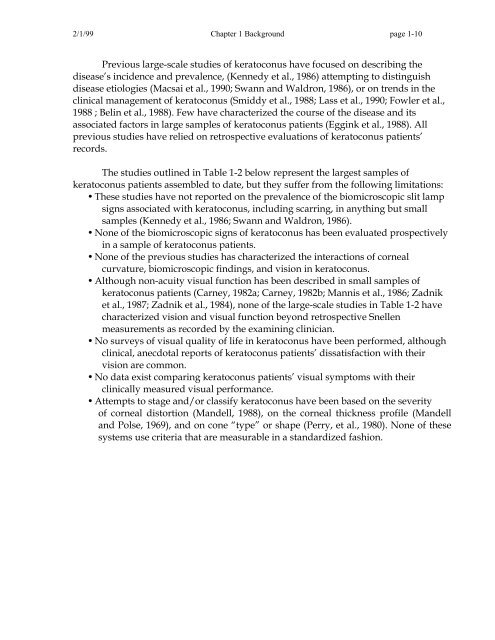OM t of c.iii - Vision Research Coordinating Center - Washington ...
OM t of c.iii - Vision Research Coordinating Center - Washington ...
OM t of c.iii - Vision Research Coordinating Center - Washington ...
Create successful ePaper yourself
Turn your PDF publications into a flip-book with our unique Google optimized e-Paper software.
2/1/99 Chapter 1 Background page 1-10<br />
Previous large-scale studies <strong>of</strong> keratoconus have focused on describing the<br />
disease’s incidence and prevalence, (Kennedy et al., 1986) attempting to distinguish<br />
disease etiologies (Macsai et al., 1990; Swann and Waldron, 1986), or on trends in the<br />
clinical management <strong>of</strong> keratoconus (Smiddy et al., 1988; Lass et al., 1990; Fowler et al.,<br />
1988 ; Belin et al., 1988). Few have characterized the course <strong>of</strong> the disease and its<br />
associated factors in large samples <strong>of</strong> keratoconus patients (Eggink et al., 1988). All<br />
previous studies have relied on retrospective evaluations <strong>of</strong> keratoconus patients’<br />
records.<br />
The studies outlined in Table 1-2 below represent the largest samples <strong>of</strong><br />
keratoconus patients assembled to date, but they suffer from the following limitations:<br />
• These studies have not reported on the prevalence <strong>of</strong> the biomicroscopic slit lamp<br />
signs associated with keratoconus, including scarring, in anything but small<br />
samples (Kennedy et al., 1986; Swann and Waldron, 1986).<br />
• None <strong>of</strong> the biomicroscopic signs <strong>of</strong> keratoconus has been evaluated prospectively<br />
in a sample <strong>of</strong> keratoconus patients.<br />
• None <strong>of</strong> the previous studies has characterized the interactions <strong>of</strong> corneal<br />
curvature, biomicroscopic findings, and vision in keratoconus.<br />
• Although non-acuity visual function has been described in small samples <strong>of</strong><br />
keratoconus patients (Carney, 1982a; Carney, 1982b; Mannis et al., 1986; Zadnik<br />
et al., 1987; Zadnik et al., 1984), none <strong>of</strong> the large-scale studies in Table 1-2 have<br />
characterized vision and visual function beyond retrospective Snellen<br />
measurements as recorded by the examining clinician.<br />
• No surveys <strong>of</strong> visual quality <strong>of</strong> life in keratoconus have been performed, although<br />
clinical, anecdotal reports <strong>of</strong> keratoconus patients’ dissatisfaction with their<br />
vision are common.<br />
• No data exist comparing keratoconus patients’ visual symptoms with their<br />
clinically measured visual performance.<br />
• Attempts to stage and/or classify keratoconus have been based on the severity<br />
<strong>of</strong> corneal distortion (Mandell, 1988), on the corneal thickness pr<strong>of</strong>ile (Mandell<br />
and Polse, 1969), and on cone “type” or shape (Perry, et al., 1980). None <strong>of</strong> these<br />
systems use criteria that are measurable in a standardized fashion.
















